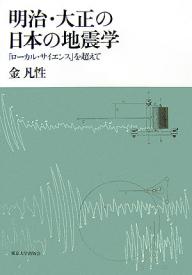Kim, Boumsoung 金凡性. 2007. Meiji · Taishō no Nihon no Jishingaku: “Rōkaru · Saiensu” o Koete. 明治・大正の日本の地震学―「ローカル・サイエンス」を超えて [Beyond Local Science: The Evolution of Japanese Seismology During the Meiji and Taisho Eras]. Tōkyō Daigaku Shuppankai. 東京大学出版会 [Tokyo University Press].
 日本の科学全般が西欧に追いつこうとしていた明治時代、日本の地震学は世界のトップを走っていた。どのようにして日本の地震学が、あるいは地震学者・大森 房吉が世界において中心的な位置に立てたのか、そしてなぜその中心的な位置からはずれたのかをダイナミックに論じる。
日本の科学全般が西欧に追いつこうとしていた明治時代、日本の地震学は世界のトップを走っていた。どのようにして日本の地震学が、あるいは地震学者・大森 房吉が世界において中心的な位置に立てたのか、そしてなぜその中心的な位置からはずれたのかをダイナミックに論じる。
序章 地震学と日本の科学史
第1章 地震計の科学、ネットワークの科学―外国人による地震研究
第2章 予防と防御の科学 ―「日本の地震学」への変容
第3章 世界を観測する ― 統計、地震計、そして大森房吉
第4章 物理学の挑戦―大森地震学の忘却
終章 「追いつき」のヒストリオグラフィーを超えて
During Japan’s Meiji period (1868-1912), when Japanese science was trying to catch up to that of the West, Japanese seismology rose to global preeminence. How did Japanese seismology, particularly seismologist Fusakichi Ōmori, come to occupy this central position in the world? Furthermore, why did they eventually lose that position? These are the questions that Kim discusses with great dynamism.
Chapter outline:
* Prologue: The histories of seismology and Japanese science
* Chapter 1: The science of seismographs, the science of networks: seismic research by gaikokujin [foreigners]
* Chapter 2: The science of prevention and protection: the changing face of Japanese seismology
* Chapter 3: To observe the world: statistics, seismographs, and Fusakichi Ōmori
* Chapter 4: The challenge of physics: the fall of Ōmori’s seismology
* Epilogue: Beyond the historiography of “catching up”
–Takashi Nishiyama, with English translation by Tyson Vaughan
![[Teach311 + COVID-19] Collective](https://blogs.ntu.edu.sg/teach311/files/2020/04/Banner.jpg)